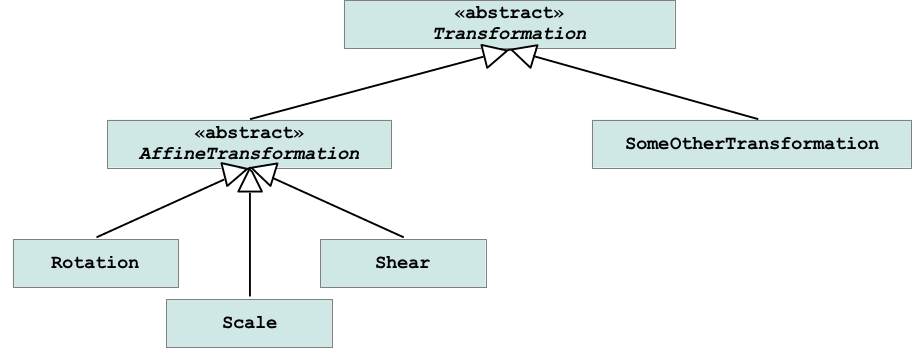CSE1030
Lab 5 Written Solutions
Tue Oct 22 and Thu Oct 24
Due: Mon Oct 28 before 11:59PM
Written Questions
The following are some written questions about inheritance based on the lab; you do not need to submit answers to these questions.
-
Do both
appplyandtransformneed to beabstractinTransformation? Explain your answer. - All of the transformations discussed in this lab including translation can be represented using a real 3x3 matrix. The matrix representation is convenient because a series of transformations applied one after another can be computed using matrix multiplication. Suppose that you wanted to add a field to represent the matrix for a transformation; in which class should the field be defined?
-
Should the method
getMatrixbe declaredabstractinTransformation? -
The transformations that can be represented using a 3x3 matrix (where the
third row of the matrix is
0 0 1) are called affine transformations. There are many other transformations that are not affine transformations, but still support the API provided byTransformation. Suppose that you want to design an inheritance hierarchy that represents affine transformations and all other transformations that support theTransformationAPI. Draw the UML diagram showing your inheritance hierarchy.
Solutions
1. No, only one of the methods needs to be abstract because the other method
can be implemented in terms of the abstract method. For example, if you make
transform abstract, then the child classes must implement
transform. The method apply could then be moved
into Transformation and implemented like so:
public Point2D apply(Point2D p) {
Point2D q = new Point2D(p); // make a copy of p
this.transform(q); // transform the copy changing its coordinates
return q; // return the transformed copy
}
Notice that apply uses none of the fields in the child, and
transform is overridden by the child, so placing it in
Transformation works just fine.
If you make
apply abstract, then the child classes must implement
apply. The method transform could then be moved
into Transformation and implemented like so:
public void transform(Point2D p) {
Point2D q = this.apply(p); // apply the transformation to p to get q
p.setX(q.getX()); // set the coordinates of p to those of q
p.setY(q.getY());
}
2. Because all of the transformations in the lab can be represented using
a real 3x3 matrix, the matrix should be defined in the Transformation
base class. The child classes would be responsible for setting the matrix
elements.
3. No, getMatrix should not be declared abstract in
Transformation because Transformation can implement
getMatrix if one of its fields is the matrix. For example:
public abstract class Transformation {
private double[][] matrix; // we could use a 2D array to store the matrix
// ...
public double[][] getMatrix() {
return this.matrix;
}
// ...
}
4. This is one possibility:

However, affine transformations have the property that any sequence
of affine transformations is also an affine transformation; e.g.,
a scale followed by a rotation followed by a shear is also an
affine transformation that can be represented as a 3x3 matrix.
Therefore, it makes sense that someone would want to create such
a transformation object, so AffineTransformation should
not be abstract.